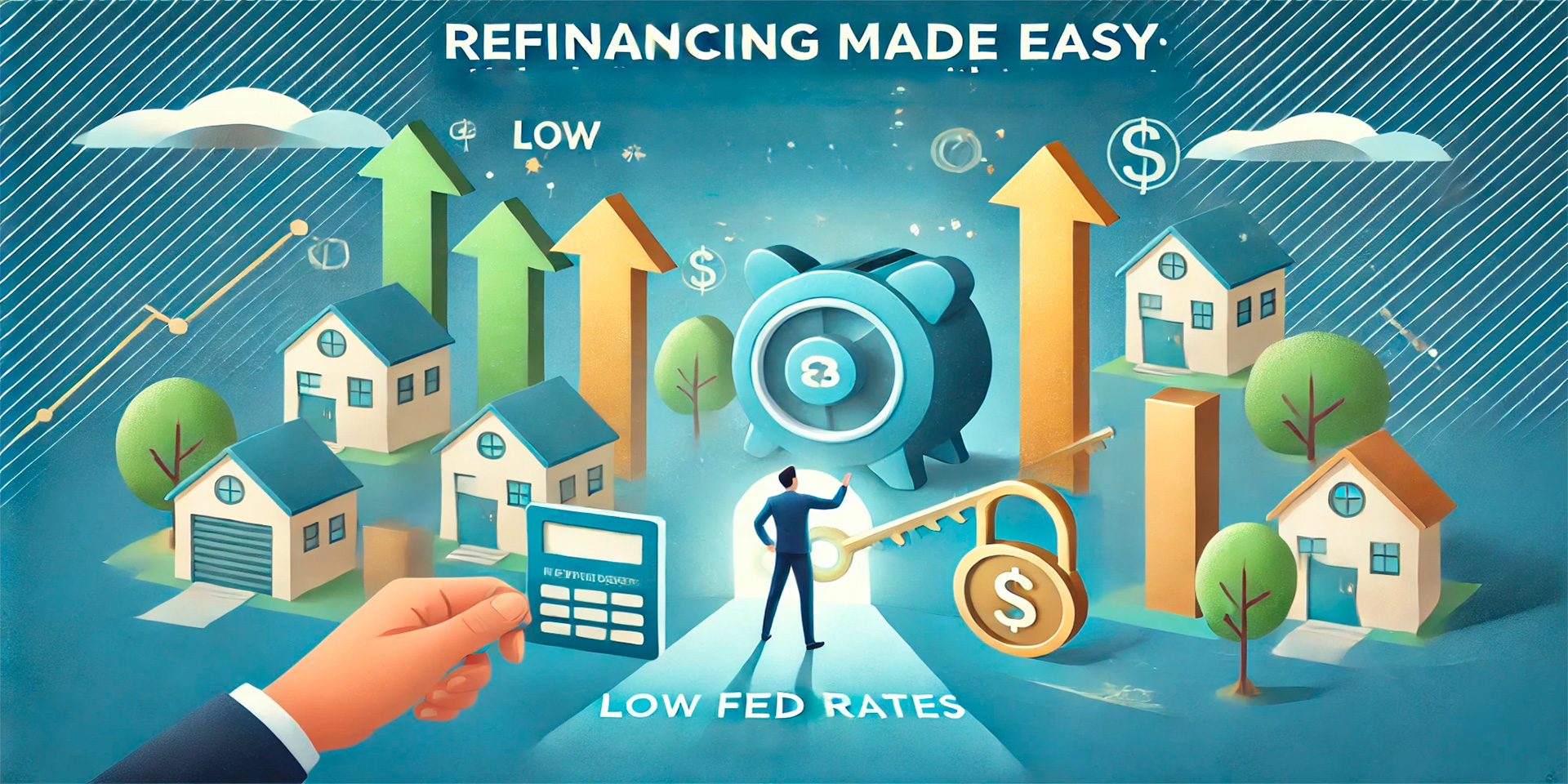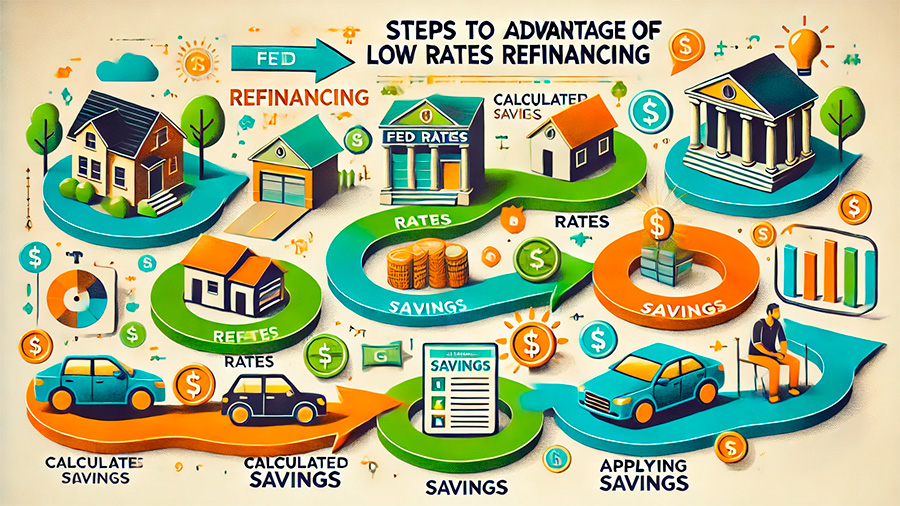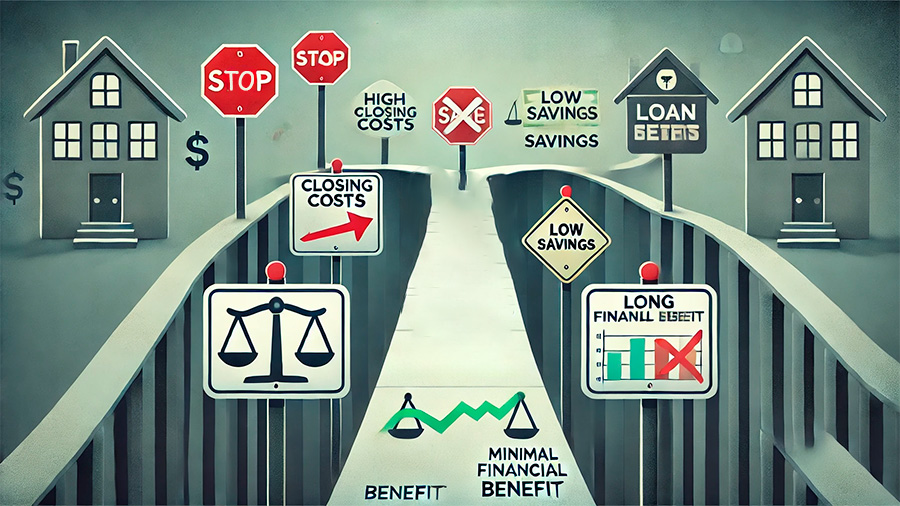
When the Federal Reserve (Fed) lowers interest rates, it creates an opportunity for borrowers to refinance their existing loans at a lower rate. Refinancing involves replacing your current loan with a new one that typically offers a reduced interest rate, resulting in lower monthly payments. Taking advantage of low Fed rates allows you to reduce the cost of borrowing, freeing up money that can be saved or reinvested elsewhere. Whether it’s a mortgage, auto loan, or personal loan, refinancing during periods of low interest rates can lead to significant financial savings.
Why Does the Fed Lower Interest Rates?
The Federal Reserve adjusts interest rates to control inflation and stimulate economic growth. During economic downturns or periods of slow growth, the Fed lowers interest rates to encourage borrowing and spending. This reduces the cost of loans, making it more affordable for consumers and businesses to take on new debt or refinance existing loans. When the Fed lowers rates, it can be a prime opportunity for individuals with higher-interest loans to refinance and benefit from lower payments.
Benefits of Refinancing Loans During Low Fed Rates
Refinancing your loans when the Fed lowers interest rates can lead to several financial benefits. Whether you’re refinancing a mortgage, auto loan, or personal loan, lower interest rates generally mean lower monthly payments, reduced interest costs over the life of the loan, and potentially more favorable loan terms. These benefits can help improve your financial situation and provide more flexibility in managing your budget.
1. Lower Monthly Payments
The most immediate benefit of refinancing during a period of low Fed rates is the reduction in monthly payments. By securing a lower interest rate, you can decrease the amount of interest charged on the remaining balance of your loan. This translates to smaller monthly payments, which can provide relief to your budget. Lower payments free up cash that can be used for other financial goals, such as saving, investing, or paying down other debts.
2. Reduce Total Interest Paid Over the Life of the Loan
Refinancing can significantly reduce the total amount of interest you’ll pay over the life of your loan. A lower interest rate means more of your payments go toward the principal balance, rather than being eaten up by interest charges. This is particularly beneficial for long-term loans like mortgages, where even a small reduction in the interest rate can save you thousands of dollars in interest payments.
3. Shorten the Loan Term
When interest rates are low, refinancing may also give you the opportunity to shorten your loan term while keeping your payments relatively manageable. For example, if you refinance a 30-year mortgage to a 15-year mortgage, you can take advantage of the lower rate to pay off your loan faster, saving a significant amount on interest. A shorter loan term can help you build equity more quickly and become debt-free sooner.

Steps to Take Advantage of Low Fed Rates for Refinancing
Refinancing during periods of low Fed rates can be a smart financial move, but it’s essential to understand the process and take the right steps to maximize your savings. Here’s a step-by-step guide to help you take advantage of low interest rates and refinance your loan effectively.
1. Assess Your Current Loan Situation
Before deciding to refinance, review the terms of your existing loan. Take note of your current interest rate, monthly payment, loan balance, and any remaining loan term. You’ll want to compare these factors with the new loan terms you could secure through refinancing. If your current interest rate is significantly higher than the market rates, refinancing is likely to result in substantial savings.
2. Check Your Credit Score
Your credit score plays a critical role in determining the interest rate you qualify for when refinancing. A higher credit score can help you secure a lower rate, while a lower score may result in higher rates or reduced chances of approval. Before applying for a refinance, check your credit score and take steps to improve it if necessary, such as paying off outstanding debts or correcting any errors on your credit report.
3. Shop Around for the Best Refinancing Rates
Different lenders offer varying interest rates and loan terms, so it’s essential to shop around and compare multiple offers before refinancing. Use online comparison tools, consult with your current lender, and reach out to other financial institutions to find the best possible rate. A small difference in interest rates can have a significant impact on your total savings over time, so it’s worth investing time in researching your options.
4. Calculate the Break-Even Point
While refinancing can lower your interest rate and monthly payments, it’s important to consider the costs associated with refinancing, such as closing fees, appraisal fees, and other charges. To determine if refinancing is worth it, calculate your break-even point—the point at which the savings from your reduced payments outweigh the costs of refinancing. If you plan to stay in the home or keep the loan beyond the break-even point, refinancing makes sense.
5. Submit Your Refinancing Application
Once you’ve found a lender with favorable terms, gather the necessary documents and submit your refinancing application. You’ll typically need proof of income, tax returns, bank statements, and details about your current loan. The lender will review your credit, financial situation, and property (for mortgages) before approving your application. If approved, you’ll move forward with the refinancing process, which may include an appraisal and other steps to finalize the new loan.
Refinancing Different Types of Loans
Refinancing opportunities are not limited to mortgages. You can take advantage of low Fed rates to refinance various types of loans, including auto loans, personal loans, and student loans. Here’s how refinancing works for different loan types:
1. Mortgage Refinancing
Mortgage refinancing is one of the most common ways to benefit from low Fed rates. Homeowners can lower their interest rate, reduce monthly payments, or even switch from an adjustable-rate mortgage (ARM) to a fixed-rate mortgage for more predictability. Additionally, mortgage refinancing allows you to cash out equity in your home for other financial needs. If mortgage rates have dropped significantly since you took out your loan, refinancing could save you thousands of dollars over the life of the loan.
2. Auto Loan Refinancing
Refinancing an auto loan can help you secure a lower interest rate and reduce your monthly payments. This is especially beneficial if your credit score has improved since you first took out the loan or if interest rates have fallen. Auto loan refinancing is typically a quick process and can provide immediate relief to your budget by lowering your car payments.
3. Student Loan Refinancing
Student loan borrowers can also take advantage of low Fed rates by refinancing their student loans. Refinancing allows you to consolidate multiple loans into a single loan with a lower interest rate, simplifying your payments and reducing overall costs. Keep in mind, however, that refinancing federal student loans with a private lender may cause you to lose certain benefits, such as income-driven repayment plans or loan forgiveness programs, so weigh your options carefully.
4. Personal Loan Refinancing
If you have a personal loan with a high interest rate, refinancing during periods of low Fed rates can help you secure a more favorable rate and lower your payments. Whether you need to pay off debt faster or improve cash flow, refinancing a personal loan can give you more financial flexibility.

When Refinancing May Not Be the Best Option
While refinancing can offer significant savings, it’s not always the best option for every borrower. There are situations where refinancing may not make sense, including if you plan to sell your home soon, if the refinancing fees outweigh the savings, or if you have a prepayment penalty on your current loan. Additionally, if your credit score has decreased since you originally took out the loan, you may not qualify for a lower interest rate.
Things to Consider Before Refinancing
- Loan Term Extension: While refinancing can lower your monthly payments, it may extend the term of your loan, meaning you’ll be in debt for a longer period.
- Closing Costs: Refinancing comes with fees, including closing costs, which can add up. Make sure the savings from a lower interest rate justify these costs.
- Prepayment Penalties: Some loans carry prepayment penalties, which are fees charged for paying off a loan early. Check if your current loan has such penalties before refinancing.
Conclusion: Capitalizing on Low Fed Rates for Refinancing
When the Federal Reserve lowers interest rates, it provides a golden opportunity for borrowers to refinance their loans and reduce their financial burden. By carefully evaluating your current loan, shopping around for the best rates, and considering the costs of refinancing, you can take advantage of these low rates to lower your monthly payments, reduce interest, and improve your overall financial situation. Whether you’re refinancing a mortgage, auto loan, student loan, or personal loan, acting quickly during periods of low Fed rates can lead to significant long-term savings.
